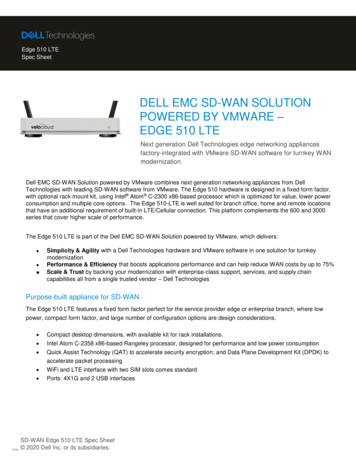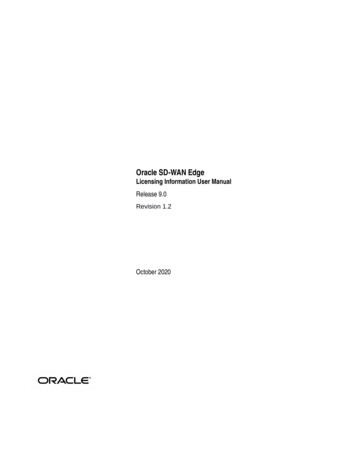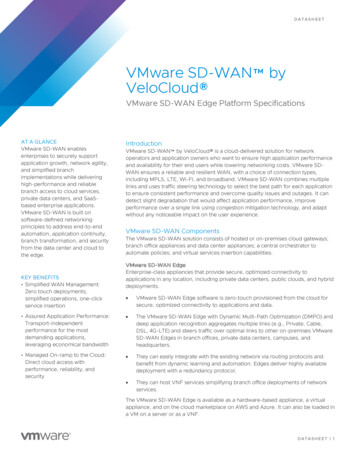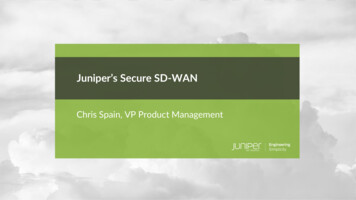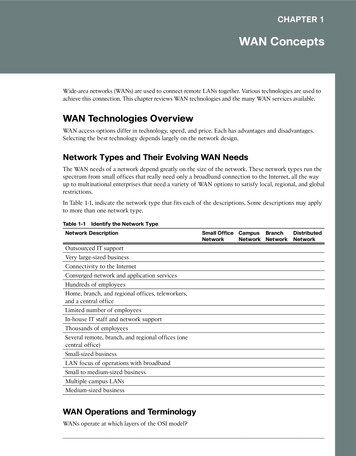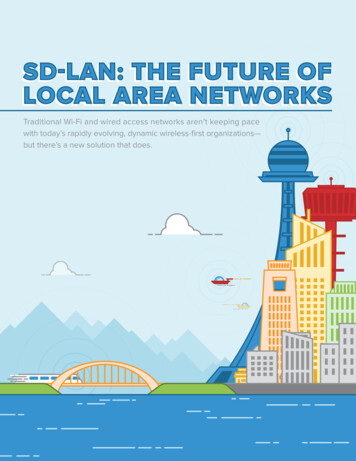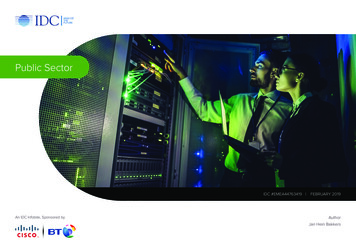
Transcription
SOLUTION OVERVIE WVMware SD-WAN andVMware NSX Data CenterA software-defined approachThe demand to rapidly decentralize the hosting and operation of business functions,in order to enhance the success of a business, is increasing. The challenge faced byorganizations in pursuit of this goal is the complete lack of visibility, control, andconsistency in a network fabric that spans the data centers and wide area networkswhere the applications that drive these business functions exist and transit.In order to successfully decentralize to achieve scale, higher levels of availability,and business agility, an organization must embrace a software-defined approach todeveloping a unique network fabric that allows an application stack to untether itselffrom the traditional data center dependencies, such as a storage area network (SAN),physical core network, core-edge, and compute machines. In a software-definedworld, an application stack can be wrapped in just-in-time networking for a path to bepaved directly from sources to destinations.To fully realize a software-defined application platform, we must look to overlaytechnologies to provide this capability. Combining overlay technologies withautomation and a decoupling of the management, control, and data planes, helps usachieve an optimal software-defined state.The VMware Virtual Cloud Network (VCN) has a broad set of capabilities for variousforms of applications. The VCN is a cloud networking fabric, with intrinsic security,powered by a network completely delivered in software.FIGURE 1: Virtual Cloud NetworkThe VCN has allowed us to commoditize both the physical network and the physicalwide area network (WAN) using two key technologies: VMware NSX Data Center forthe data center and VMware SD-WAN by VeloCloud for the WAN.1
VMware SD-WAN and VMware NSX Data CenterProviding seamless connectivity and integrationHow do we go about providing seamless connectivity and integration into eachrespective domain?To start, if your deployment has already leveraged software-defined wide areanetwork (SD-WAN) and you have an island of resources serviced and protected byVMware NSX Data Center, you have achieved an initial state connectivity. This initialstate allows you to leave intact your existing NSX footprint by utilizing an SD-WANenabled branch to create a non-VMware SD-WAN site (NVS) connection to thisisland. An NVS is simply a mechanism for connecting a non-SD-WAN site. This maybe due to an acquisition of a company or simple consolidation of various resourceislands. With an NVS, an IPsec tunnel with appropriate parameters is established froman edge/hub to a VMware SD-WAN Gateway, and from the Gateway to the VMwareNSX Data Center Edge for IPsec termination.Once you are ready to extend further SD-WAN capabilities, you can then deploy aphysical or virtual VMware SD-WAN Edge appliance in the same data center whereVMware NSX Data Center lives. This setup is advantageous because you are trulyleveraging the software-defined fabric to support the needs of your applications,regardless of where they reside.VMware NSX Data Center key conceptsVMware NSX Data Center decouples networking and security functions from physicalhardware components and delivers an abstraction completely in software.Traditionally, networking functions are performed by physical appliances that containintegrated data planes (packet forwarding), control planes (networking protocols) andmanagement planes (the CLI). At the same time, the control plane is, by necessity,distributed and relies on collaboration and synchronization between the physicaldevices in order to establish a forwarding fabric.The Software-Defined Data Center (SDDC) takes the approach of separating the data,control, and management planes and uses a centralized control plane in the form ofcontrollers and a centralized management plane for configuration, troubleshooting,and more. These reside as three highly available and federated virtual appliances invirtual machine (VM) format. Each appliance contains both the management planefunction, as well as the controller function. The VMware NSX Data Center data plane iswhere all NSX application traffic is routed, forwarded and firewalled efficiently.The NSX Data Center data plane consists of familiar networking functions such as: Overlay switching High-performance distributed routing– Logical routing done in hypervisor kernel– Optimizes routing for east-west communication– Routing done closest to source Distributed L2-L7 firewalling– High-performance east-west firewall– Delivery of context-aware microsegmentation– Kernel-based, distributed amongst all hostsSOLUTION OVERVIE W 2
VMware SD-WAN and VMware NSX Data CenterWith further data plane extensions made possible by the platform to achieve theextensive ecosystem. Figure 2 highlights key VMware NSX Data Center capabilities.Overlay switching by VMware NSX allows for Layer 2 to span Layer 3 using overlaytechniques, such as Virtual Extensible LAN (VXLAN) or Generic Network VirtualizationEncapsulation (GENEVE). This capability allows IP subnets to stretch across Layer 3boundaries, across geographical locations. This addresses significant use casesaround disaster recovery and workload mobility.FIGURE 2: VMware NSX Data Center networking and security capabilitiesVMware NSX Data Center is hypervisor and cloud-agnostic and is meant to provide aunified security and networking framework, delivered in software, to any kind ofworkload. NSX Data Center is meant for true workload decentralization and hybridity.NSX Data Center natively provides tenancy using the concept of tiered gateways.Currently, NSX-T Data Center supports multiple Tier-0 (T0) gateways, with numerousTier-1 (T1) gateways. T1 gateways act as points of tenancy where multiple T1 gatewaysare deployed and are backed to T0 gateways. This provides great scale for multipleoperating environments and allows for overlapping subnets within a givenenvironment. In short, the T1 acts as a distributed routing entity to enhance east-westcommunications, while the T0 acts as a centralized routing entity to provide statefulservices and connectivity to the physical network. The T0 provides much morefunctionality, specifically, north-south communication, Border Gateway Protocol(BGP), and virtual private network (VPN) capabilities. This will align to VMwareSD-WAN segments. T1 gateways can also provide IPsec VPN capabilities.NSX Data Center has native capabilities for security. More specifically, it hasmicro-segmentation capabilities in which two or more entities, regardless of whichnetworks they are a part of (same or different), can be segmented at a micro level.Effectively, this is the concept of bringing security, or more specifically, distributedfirewalling, closest to the workload. In short, two or more end-point objects will haverespective L2-L7 firewalls, which police traffic both on the ingress and egress. Theconcept of security adheres to the model where security follows the workload.SOLUTION OVERVIE W 3
VMware SD-WAN and VMware NSX Data CenterVMware SD-WAN key conceptsVMware SD-WAN is a cloud delivered software-defined WAN solution that providesassured application performance, delivers east on-ramp to the cloud, and providessimplified management. VMware SD-WAN aims to simplify connectivity, whileproviding security from branches to data centers and cloud locations.The VMware SD-WAN solution is comprised of a decoupled management, control,and data plane. The management plane is the VMware SD-WAN Orchestrator. It isthe single pane of glass for all management, operations, and visibility. All activitiesstart at the VMware SD-WAN Orchestrator from configuring, operating, andmonitoring to troubleshooting.The control plane is a function of the VMware SD-WAN Gateways, in which theVMware SD-WAN Gateways deployed in the cloud act as learning agents for theentire SD-WAN. They act as mid-mile constructs which get us to the last mile. TheVMware SD-WAN Gateways learn routes and prefixes and maintain this informationwith the VMware SD-WAN Orchestrator. The VMware SD-WAN Gateways, beingstateless, obtain configuration from the Orchestrator, giving us immense scalability.VMware SD-WAN Gateways can be deployed non-impactfully, while providingincreased horizontal scale. The VMware SD-WAN Gateways can be leveraged as adata plane if there is a requirement to connect to an NVS or any software as a service(SaaS)-based offering.The VMware SD-WAN Edge is the final piece of the puzzle, which acts as the primarydata plane of the solution. While maintaining a database of all clients connected, theVMware SD-WAN Edge is used to make intelligent steering decisions of applicationtraffic using an umbrella of technologies. We refer to this umbrella as VMwareSD-WAN Dynamic Multipath Optimization (DMPO). The VMware SD-WAN Edgeuses DMPO to make intelligent decisions about whether to send and steer traffic on aparticular link, or all links. DMPO also enables sub-second failover to secondary,tertiary or even quaternary links to ensure a particular stream of traffic isn’t droppedmid-flow.Flexibility in deploymentVirtual , andmonitoring portalOptimized cloudon-ramp to thedoorstep ofSaas/IaaSFor branch,data center &cloud Purplose-built hardware Virtual Edge for cloud or white box Services platform for VNFVMware orservice providerhosted, andon-premises atenterpriseFully managedand operated byVMware ntAPIsEnables fastdeployment,zero touchoperationsStrategicworldwidelocations, top-tiernetwork PoPsFIGURE 3: VMware SD-WAN componentsSOLUTION OVERVIE W 4
VMware SD-WAN and VMware NSX Data CenterAs defined by Gartner, key capabilities of an SD-WAN solution must include thefollowing: Transport independence Secure overlay Dynamic path selection Simple interfaceVMware SD-WAN strongly adheres to these key capabilities and more, while alsoadhering to key business values, including, cloud on-ramp, assured applicationperformance and simplified WAN management. Let’s have a look at key features ofthe solution that help address unique use cases.Zero touch deploymentThe ability to minimally touch a VMware SD-WAN Edge, while the deployment of thisEdge is done through the VMware SD-WAN Orchestrator.Redundancy and scaleBeing able to achieve redundancy using high-availabilities principles on both theVMware SD-WAN Edge and VMware SD-WAN Orchestrator side. The VMwareSD-WAN Edge can be deployed in a high availability (HA) pair for active/standbytraffic operations, or active/active in a clustered configuration. The VMware SD-WANOrchestrator is backed onto cloud technologies and is built on cloud HA principles.The VMware SD-WAN Gateway, as a stateless entity, can be spun up on-demand,and torn down when required. This provides horizontal scale.Assured application performanceDMPO provides the following key capabilities which contribute to the overallVMware SD-WAN solution. Deep application recognition engine (DAR) – A deep packet inspection (DPI)engine containing 3000 applications for correct recognition and classification oftraffic. Overlay protocol – VeloCloud Management Protocol (VCMP) is the tunnelingmechanism that allows for multitenancy and segmentation, while, at the same timeallowing for utilization for multiple links. Re-assembly of packets is done using theVMware SD-WAN Edge. Link qualification – Measurements of bandwidth, latency, jitter, and packet loss tobe populated and calculated in the VMware SD-WAN Orchestrator for the beststeering of traffic. Application-based steering – Leveraging business policy to steer traffic accordingto traffic type and provide on-demand remediation. On-demand link remediation – Leveraging forward error correction (FEC),negative-acknowledgement (NACK), and de-jitter buffer to condition the link andprovide sub-second steering. Business policy framework – A policy-link framework that resembles a firewall ruletable but simply dictates how traffic should flow out of a VMware SD-WAN Edge. Cloud VPN – The simplification of construction of VPN tunnels from site-to-site,site-to-hub, or site-to-NVS, using a few checkboxes. This feature will automaticallyconstruct IPsec VPN tunnels to respective locations based on traffic needs. Routing capabilities – With routing configurations around BGP, Open Shortest PathFirst (OSPF) and static routes with IP service-level agreement (SLA), you can clickyour way to a simple routed design or something a touch more complex. Segmentation – This main security and tenancy feature of the VMware SD-WANsolution, is what is used to separate different types of traffic from product to test toSOLUTION OVERVIE W 5
VMware SD-WAN and VMware NSX Data Centerpayment card industry/cardholder data environment (PCI/CDE). Security service chaining – While the VMware SD-WAN Edge provides a localfirewall, sometimes it might be necessary to service chain to an industry-standardunified threat management (UTM) appliance. Using automation and the principles ofvirtualization, the ability to run a virtual network function (VNF)-firewall alongside theSD-WAN software in a singular box, is entirely achievable. API and automation capabilities – The API is made available for those wishing tointegrate into a third-party system, or to leverage programmatic languages tocapture information from the VMware SD-WAN Orchestrator.SD-WAN connecting to a non-VMware SD-WAN siteTypically, if an SD-WAN solution is already deployed, it is highly likely that it has beendeployed in a phased approach. Certain sites may not be SD-WAN enabled, meaningthey may not have an SD-WAN edge deployed at the branch. How do these sitesconnect back? The current two options are by specifying a particular site as aNon-VMware SD-WAN site (NVS) and connecting via IPsec or, by going directthrough the private underlay via Multiprotocol Label Switching (MPLS) or equivalentcircuit.When reaching an NVS site direct through the underlay, the Overlay Flow Control(OFC) table is leveraged. In the OFC, we can observe a route that specifies a branchprefix being reachable only through this direct underlay.When not going through the underlay, this site can be specified as an NVS andthrough the Cloud VPN, an IPsec VPN can be deployed. In this scenario, we arecalling on the VMware SD-WAN Gateways (or designated Hubs) to construct the lastmile VPN. In certain situations, the site in question might be a potential future hub. Asa result, the VMware SD-WAN Gateways must be used to establish IPsec tunnels tothis location. Through the VMware SD-WAN Orchestrator the NVS is deployed and anIPSec configuration for the NVS site’s branch device is created for simplification andease of configuration. Once the configuration is applied, we can verify the connectionstate as being up in the VMware SD-WAN Orchestrator. We can additionally see theevents within the VMware SD-WAN Orchestrator to see a tunnel established.FIGURE 4: VMware SD-WAN to NVSSOLUTION OVERVIE W 6
VMware SD-WAN and VMware NSX Data CenterOnce we’ve established an IPsec VPN to an NVS using the VMware SD-WANGateways, we now have connectivity between SD-WAN enabled branches and NVSsites. Branch locations enabled for SD-WAN can reach applications or functions withinthe data center, which is now an NVS. The NVS site is the data center containingNSX Data Center. The point of VPN termination can either be the T0 gateway or T1gateway in NSX-T Data Center.VMware SD-WAN segment extension into NSX Data CenterWith VMware SD-WAN, the concept of isolation and security is provided usingsegmentation. Segmentation allows for a VCMP tunnel to carry a specific segmentheader for a given Enterprise ID. For example, an Enterprise ID might contain multipledifferent segments that cannot communicate with each other such as, voice/video,PCI, guest, corporate, or customer-facing segments. These can be analogous tovirtual routing and forwarding (VRF) in the routing world. Each segment can beconfigured on a profile level; edges assigned to a profile will inherit the segments andcapabilities configured within each segment.In NSX-T Data Center, the concept of isolation, tenancy, and security is achievedusing the tiered routing constructs, the T0 or T1 gateways. The T0 gateway can becomprised of both service router and distributed router constructs. With the T0 SR,we can establish BGP connectivity north-bound. With the ability to establishconnectivity, we can now effectively peer, on a per-segment basis, from multiple T0sto multiple segments. More specifically, each T0 deployed will house a tenant orsegment, and that specific T0 will map to a VMware SD-WAN segment. By doing so,only the necessary prefixes originating from each individual T0 will be shared intoeach respective segment. Prefixes will not be learned on all segments, only the onesmapped to their T0 segment association. Once achieved, VRF-like isolation ispresent, and all segments and tenants communicate within their respective segments,while still maintaining isolation.Take, for example, a CDE that must be PCI compliant. This requirement of CDE is thatit must maintain isolation from the current production network. In NSX-T Data Centeryou will leverage the T0 and its connected logical networks, and it will be isolatedfrom other networks backed onto other T0 gateways. Those same T0 gateways willmap and connect to their respective segments in VMware SD-WAN. The PCI segmentconfigured on the VMware SD-WAN Edge will map to the PCI specific T0 gateway.Isolation is present all throughout both software-defined environments, providingsecure end-to-end segmentation and connecting NSX-T Data Center together withVMware SD-WAN.VMwareSD-WANGatewayFIGURE 5: VMware SD-WAN segments extended into NSX Data CenterSOLUTION OVERVIE W 7
VMware SD-WAN and VMware NSX Data CenterEnd-to-end visibility with vRealize Network Insight andVMware SD-WANvRealize Network Insight (vRNI) is an end-to-end network visibility solution whichallows administrators to visualize how traffic moves from one endpoint to anotherwithin a data center and from branches to data centers to clouds. vRNI uses telemetryand metadata typically from compute managers, like vCenter, as well as cloudenvironments, such as Amazon Web Services (AWS), and Microsoft Azure. Using theAPIs of vCenter, AWS, Azure and others, data about objects are shared with vRNI.Additionally, IP Flow Information Export (IPFIX) and NetFlow information of variousnetwork devices is captured to understand and correlate flow data to metadata. Withenhancements to VMware SD-WAN’s visibility and capabilities around IPFIX andNetFlow, flow records from client endpoints originating from VMware SD-WAN Edgescan be populated within vRNI. The overlay and underlay health of VMware SD-WANbranches, in addition to traffic metrics, packet metrics, and which applications arebeing accessed, are all shared with vRNI using the VMware SD-WAN Orchestrator’sAPI.With vRNI having full visibility into VMware SD-WAN and NSX Data Center, we nowhave full end-to-end visibility from a branch user flowing through a VMware SD-WANEdge to an application protected by NSX Data Center, allowing for a very powerfulDay-2 operations tool.Looking aheadWhile integrations are already in-place to support VMware SD-WAN and NSXconnectivity and visibility, further integrations will be made available. Looking ahead,policy management and automation between SD-WAN and NSX will be the nextmajor development.While both VMware SD-WAN and NSX Data Center offer software-defined solutionsin their respective spaces, both technologies can collaborate together to provide aunified, secure connective fabric. This fabric is delivered in software to allow completeagility and consistent performance of applications. As both technologies continue togrow, there will be additional integrations to ensure the best possible and consistentexperience for any device, any application, and any cloud.For more information see, www.velocloud.com.VMware, Inc. 3401 Hillview Avenue Palo Alto CA 94304 USA Tel 877-486-9273 Fax 650-427-5001 vmware.com Copyright 2020 VMware, Inc.All rights reserved. This product is protected by U.S. and international copyright and intellectual property laws. VMware products are covered by one or more patentslisted at vmware.com/go/patents. VMware is a registered trademark or trademark of VMware, Inc. and its subsidiaries in the United States and other jurisdictions.All other marks and names mentioned herein may be trademarks of their respective companies. Item No: sdwan-879-vmware-nsx-data-center-so-0420 5/19
VMware SD-WAN Edge is used to make intelligent steering decisions of application traffic using an umbrella of technologies. We refer to this umbrella as VMware SD-WAN Dynamic Multipath Optimization (DMPO). The VMware SD-WAN Edge uses DMPO to make intelligent decisions about whether to send and steer traffic on a particular link, or all links.

